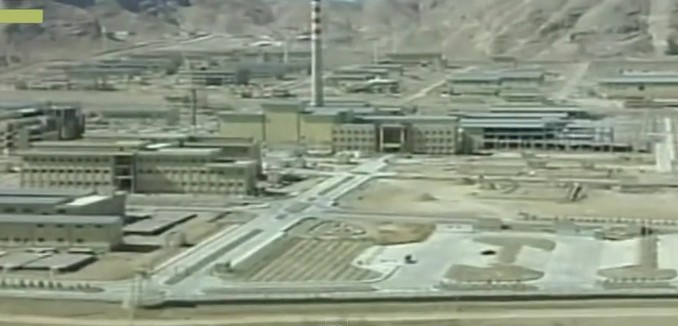A phased nuclear deal that will allow Iran “to slowly ramp up activities that could be used to make weapons” is currently taking shape between the P5+1 nations and Iran, the Associated Press (AP) reported today.
The U.S. initially sought restrictions lasting for up to 20 years; Iran had pushed for less than a decade. The prospective deal appears to be somewhere in the middle.
One variation being discussed would place at least 10-year regime of strict controls on Iran’s uranium enrichment program. If Iran complies, the restrictions would be gradually lifted over the last five years of such an agreement.
Iran could be allowed to operate significantly more centrifuges than the U.S. administration first demanded, though at lower capacity than they currently run. Several officials spoke of 6,500 centrifuges as a potential point of compromise, with the U.S. trying to restrict them to Iran’s mainstay IR-1 model instead of more advanced machines.
While the AP observes that “any deal would depend more on technical safeguards than Iranian goodwill to ensure compliance,” it doesn’t appear that the emerging deal takes into account the possible military dimensions (PMD) of Iran’s past nuclear research.
The significance of this omission was highlighted by Yukiya Amano, the Director General of the United Nations’ nuclear watchdog agency, the International Atomic Energy Agency (IAEA), who observed last month that his agency could not verify that “all nuclear material in Iran is in peaceful activities.” Amano specifically said:
As far as Iran is concerned, the Agency is able to verify the non-diversion of nuclear material declared to us by Iran under its Safeguards Agreement.
But we are not in a position to provide credible assurance about the absence of undeclared nuclear material and activities in Iran, and therefore to conclude that all nuclear material in Iran is in peaceful activities.
The IAEA has regularly reported that Iran has not come clean about its past nuclear research, something it was obligated to do according to the November 2013 Joint Plan of Action (JPOA), which stated (.pdf) that Iran had to work “with the IAEA to facilitate resolution of past and present issues of concern.”
It will be impossible to verify Iran’s future compliance without knowing the full scope of its past nuclear research, as Omri Ceren, The Israel Project’s managing director for press and strategy, wrote last October. The Israel Project publishes The Tower.
At stake are international concerns over the so-called possible military dimensions (PMDs) of the Iranian nuclear program, the central significance of which has sometimes been underplayed by voices within the foreign policy community. While the P5+1 is charged with negotiating over Iran’s uranium work, its plutonium work, and its ballistic missile work – all of which the Iranians are obligated by half a dozen United Nations Security Council (UNSC) resolutions to roll back – the IAEA seeks to establish the scope of Iran’s overall atomic program, including in those three more specific areas.
The mandate stretches beyond full-blown weaponization work, and into military involvement in uranium mining, centrifuge construction, and so on. Full Iranian disclosure is considered a minimum to establishing a robust verification regime: The IAEA can’t verify that Iran has met its obligations to limit uranium work, for instance, unless it knows the full scope of the uranium work that’s being done. PMD-related transparency is seen as not just another issue – say, one that Iran could refuse to trade away by making concessions in other areas – but as a prerequisite to verifying Iranian compliance across all issues.
Already in November it was reported that the West would cave on its demand for full disclosure from Iran. As the AP reported today, the West is giving in to Tehran’s demands in other areas of the deal, including those regarding the number of centrifuges it will allow Iran to operate and the length of the time restrictions placed on Iran’s enrichment activities.
The provision governing the length of time the restrictions on Iran’s enrichment program will apply, known as the “sunset clause,” is also significant as Mark Dubowitz and Reuel Marc Gerecht of the Foundation for Defense of Democracies wrote last August:
Negotiators have recognized the regime’s “right” to uranium enrichment; they appear ready to accept several thousand operational centrifuges and Iran’s “right” to advanced centrifuge research and development at the buried-in-the-mountain Fordow site. President Obama has also accepted the idea of a “sunset clause” on any agreement (Tehran has suggested three to seven years; Washington wants more than 10), which means that eventually the regime could legally develop an industrial-size enrichment program, reducing its bomb breakout time to days and increasing the risk of uranium diversion to covert sites.
The expiration of all restrictions on Iran’s ability to enrich uranium will leave the Islamic Republic free to enrich the necessary materials to create a nuclear weapon with no international oversight or window for a timely response.
Last week, Israel’s minister of intelligence Yuval Steinitz argued that one of the assumptions of a reduced time for the restrictions – that the nature of the Iranian regime would change – was “speculative.”
In How a Weak Iran Deal Makes Us All Less Safe and War More Likely, which was published in the January 2014 issue of The Tower Magazine, Emanuele Ottolenghi warned:
Similar to the sanctions easing, the interim deal has fatally undermined the NPT by watering down Iran’s compliance obligations, undercutting the IAEA’s authority in matters of verification, and ignoring the military dimensions of the program documented by the Agency, which are all at the heart of the dispute. In fact, if a final agreement were to emerge that fails to address the flaws present in the interim deal, including continued enrichment work, Iran would be able to break out under the cover of the NPT.
[Photo: Financial Times / YouTube ]




